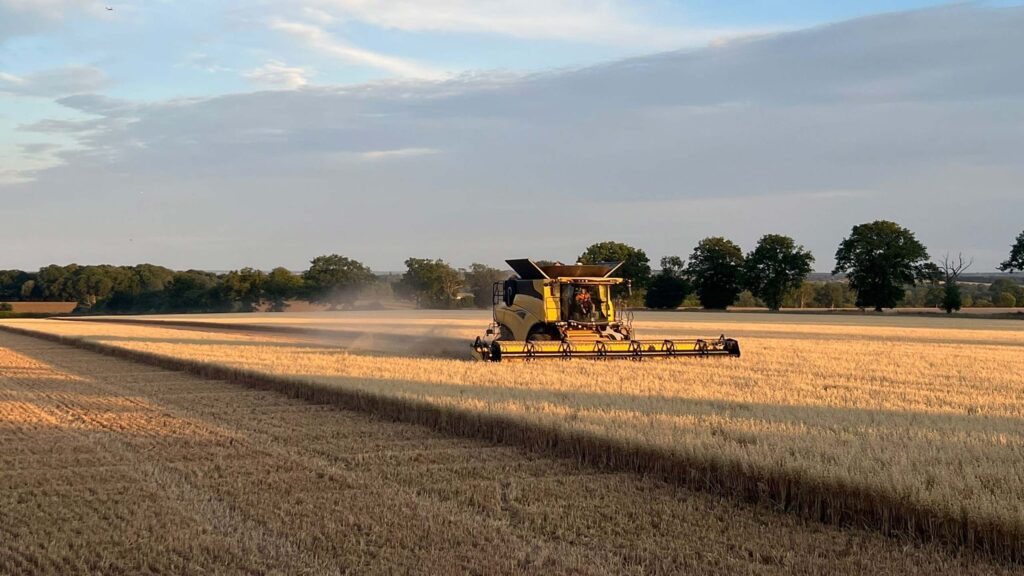Harvest 2025: Yields reflect uncertainty of drought-hit season
 © William Brewis
© William Brewis Rain has hindered harvest progress in some parts of the country this week, with crops on heavier land performing better than their lighter land counterparts.
See also: Harvest round-up: A season of record-breaking early starts
Bedfordshire
Ed Ford of Childerditch Hall Farm has felt the impact of this year’s dry conditions, with yields well below average.
“We’ve finished 91ha of Graham feed wheat, averaging just 4.99t/ha,” he says.
“Our worst field came in at 3.83t/ha, and the best managed 6.56t/ha. It’s been really variable, depending on soil type.”
He has cut 18ha of Laureate spring barley, yielding 2.42t/ha and 2.72t/ha.
“We’re not sure on quality yet, as it’s being sent off today,” he adds.
With only a quarter of the harvest completed, there’s still a fair way to go.
“We’ve got canary seed, poppies, more spring barley, and the remaining Graham and Skyfall to do.”
However, conditions are looking slightly better on his Essex land.
“That farm is on heavier land, which has held on to moisture better, so we’re hopeful for a bit more out of it.”
Essex
It has been a tough year for Tom Fairley at T&R Fairley Farms near Little Bromley, with their 80ha of Craft winter barley yielding just 7.2t/ha.
“The Carrington peas have been poor too, yielding only 2.72t/ha. But peas are peas – this kind of result isn’t unusual,” Tom says.
So far they have cut 200ha of their Zyatt and Skyfall wheat, yielding 9t/ha, with the second wheats dropping to 7t/ha, making overall yields down 30% on last year.
Moisture content in the wheat has ranged from 13% to 15%, with an early morning sample reaching 16%.
“Despite my worries, the wheat has made milling spec,” says Tom. “All the barley except one small field has hit malting quality.
“It’s looked pretty bleak out here with only 8in of rain since January.
“At this rate, we’ll be finishing combining by August, but there’s not much we can do after that until we get some more rain.”
There is still 20ha of spring barley to harvest, but it looks thin and short, reflecting the difficulties of this season.
Yorkshire
It’s been a slower start to harvest for Ben Parker of Hartley Farming, near Tadcaster. He began combining 25ha of Tardis winter barley on 12 July, with moisture at 14.5%.
“Yields have been pleasing, just over 9.2t/ha,” says Ben. “It’s the high grain weights carrying the crop, rather than a big ear count.”
The barley was drilled slightly later than usual, but yields have remained consistent.
“It’s limestone land, so although we only had 56mm of rain, it held on to it well. We didn’t struggle with drought here, unlike some areas,” he adds.
The crop came into the store hot, but overall performance has been solid.
Ben started on 25ha of his Attica oilseed rape on 18 July with moisture at 8.2%.
“It was established early and has come through cabbage stem flea beetle, pigeons, and everything else,” says Ben.
“It looks good from the outside, but as always with oilseed rape, you never really know until you get into it.”
Wheat is about seven days away on the sandier ground, while heavier land is still two weeks off.
Lincolnshire
At Grange Farm near Rippingale, Ben Atkinson has finished his oilseed rape and winter barley. The 101ha of Duke oilseed rape achieved 4.2t/ha, with a good oil content of 46-47%.
“We have dropped oilseed rape from the rotation next year, but this year was a pleasant surprise,” Ben says.
The 283ha of Kingston winter barley fared well, achieving average yields.
“It wasn’t record-breaking, but we had a decent 8.5-9t/ha, with some hitting 10t/ha and others 7t/ha,” he says.
He made a start to his 1,400ha of wheat on 18 July, first with the variety Dawsum.
Ben has concerns over spring crops. “In south Lincolnshire, some of the crops have had so little rain, I think they might let us down this year.”

